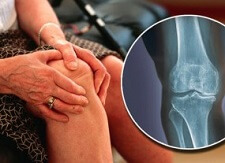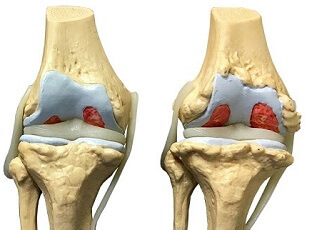- Home
- Knee Arthritis
- Stages
Osteoarthritis Knee Pain:
Stages & Progression
Written By: Chloe Wilson, BSc(Hons) Physiotherapy
Reviewed by: KPE Medical Review Board
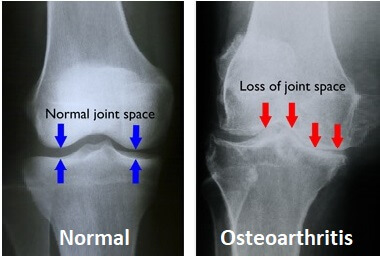
Osteoarthritis knee pain is a common problem that usually comes on gradually over a number of years.
It is caused by thinning and "wear and tear" of the knee cartilage and bones and affects more than 1 in 10 people. Osteoarthritis is a progressive condition meaning it tends to gradually worsen over time.
The symptoms of knee arthritis vary from person to person and the disease progresses at different rates in different people. Some people may experience a slow progression over many years, while others may have a more rapid deterioration. Various factors, including age, genetics, joint stress, previous injuries, and obesity, can influence the rate of progression.
How Is Osteoarthritis Categorized?
Knee osteoarthritis can be classified into four different stages:
- Initial Stages
- Mild Arthritis
- Moderate Arthritis
- Severe Arthritis
Often mild arthritis will stay at that level, however, sometimes it progresses.
Here we will look at how the different stages of knee osteoarthritis are classified, how they differ from each other and the common symptoms at each stage. To find out more about arthritis, including symptoms, diagnosis and treatment options, visit the knee arthritis guide.
Stages of Osteoarthritis Knee Pain
When thinking about the stages of osteoarthritis knee pain there are two important factors to consider:
- Symptoms: the level of arthritis knee pain, stiffness and activity limitation that a person experiences - i.e. how "bad" it feels
- X-ray Findings: the level of cartilage & bone degeneration, and bone spur formation found on x-ray - i.e. how much joint damage there actually is
Surprisingly, there is often very little correlation between the two. Some people demonstrate advanced knee arthritis on x-ray but have minimal symptoms, whereas other people suffering from a great deal of osteoarthritis knee pain may only show mild changes on x-ray.
In general, it is much more important to concentrate on your symptoms, rather than what your x-ray shows.
Knee arthritis progresses through four different stages:
1. Initial Stage
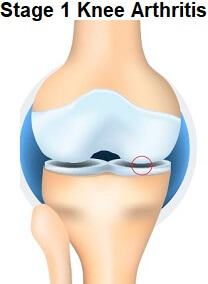
In the very early stages, knee arthritis is often classed as being "doubtful", and people often don't notice any symptoms at all at this stage.
- Stage 1 Symptoms: may consist of the occasional "twinge" in the knee but they most likely won't be affecting function or limiting knee movement
- Stage 1 X-rays: typically show little disruption to the joint surface and there will be less than 10% loss of knee cartilage.
2. Mild Knee Arthritis
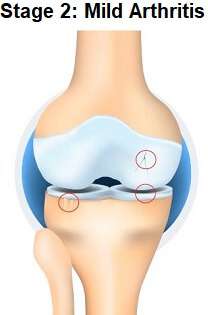
The technical term for this stage is Early Degenerative Changes. In the early stages of osteoarthritis of the knee, again, there may be no significant symptoms at all.
- Stage 2 Symptoms: usually start with a generalised ache around the knee and
stiffness, especially after prolonged periods in one position e.g. after
sitting, when getting up in the morning or after lots of exercise.
People often get pain when going down stairs or getting up from a chair.
- Stage 2 X-rays: will usually show minimal changes to the bone and cartilage. There may be some mild narrowing of the joint space (the gap between the bones), and a few small bone spurs may have formed. The cartilage will show some signs of wearing away.
There are a number of treatment options that can help reduce symptoms and stop progression of the knee arthritis at this stage.
3. Moderate Knee Arthritis
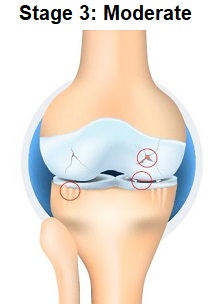
The technical term for this stage is Moderately Advanced Arthritis.
- Stage 3 Symptoms: at this stage are more noticeable with moderate osteoarthritis knee pain. The knee may start
to swell and/or stiffen. It may not be able to bend and straighten
fully and sometimes the joint starts to make funny noises e.g. creaking or
cracking noises.
- Stage 3 X-rays: will often show moderate narrowing of the joint space and loss of the smooth surface of the bones with some osteophyte formation - bony knee spurs. Cartilage damage may extend down to the bone.
Again, there are a whole range of treatment options including specially designed knee braces, injections and exercises that can help at this stage - visit the arthritis treatment section to find out more.
4. Severe Knee Arthritis
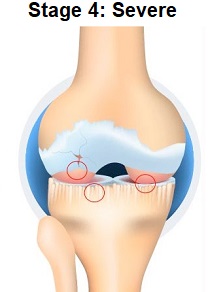
The technical term for this stage is Advanced Arthritis.
- Stage 4 Symptoms: can be quite intense by this stage. Osteoarthritis knee pain can end
up so severe that normal daily activities such as walking and going down
stairs become extremely painful and difficult. The knee can also become deformed.
- Stage 4 X-rays: may show complete loss of joint space with a number of large osteophytes. Typically more than 60% of the cartilage is lost. This all leads to bone rubbing on bone which causes pain and limits movement.
With advanced knee osteoarthritis, the best course of action for osteoarthritis knee pain is usually a knee replacement.
Treating Osteoarthritis Knee Pain
The best treatment for osteoarthritis knee pain will depend on which stage your arthritis is at and the symptoms you are feeling but will typically include:
- Exercises: To improve the strength, stability, mobility and flexibility of the knee
- Knee Brace: to support the knee and off-load the damaged part of the joint
- Home Remedies: such as ice, heat, weight loss and pacing your activities
- Supplements: natural remedies and homeopathy e.g. glucosamine and chondroitin
- Dietary Changes: knowing what foods to eat and which ones to avoid can really help to reduce osteoarthritis knee pain
- Surgery: to removed the damaged cartilage and in some cases, replace the joint altogether
You can find out all about the best ways to treat osteoarthritis knee pain in the Knee Arthritis Treatment section.
You may also be interested in the following articles
- Knee Arthritis Overview
- Causes Of Knee Arthritis
- Knee Arthritis Symptoms & Diagnosis
- Knee Arthritis Book
- Inner Knee Pain
- Front Knee Pain
Page Last Updated: 24/05/23
Next Review Due: 24/05/25
